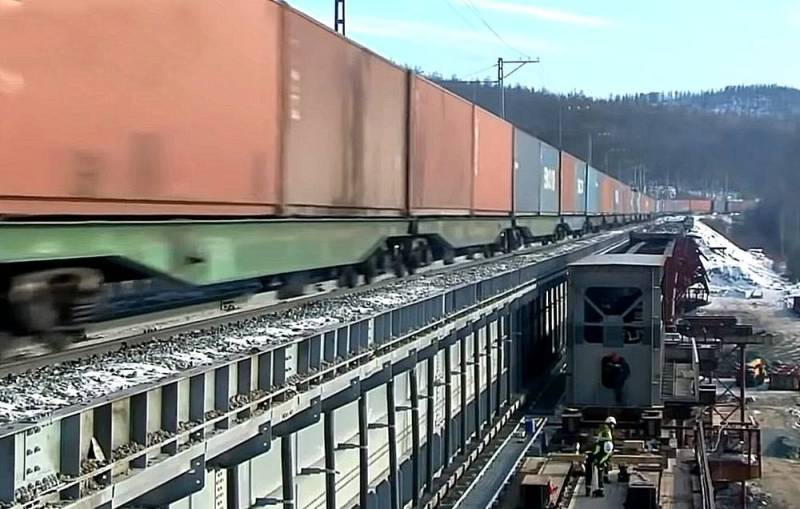For a real turn to the East, Russia will have to build BAM-2 and Trans-Siberian-2
The coup d'état that took place in Ukraine in 2014 naturally led to the loss of part of the territory by Kyiv, the beginning of the ATO in Donbass, two iterations of the Minsk agreements, the beginning of the NVO and, as a final result, for which Maidan was touched, the rupture of all trade and business ties between Russia, on the one hand, and Ukraine and the European Union, on the other. Today, in addition to a real turn to the East, there are special alternatives for our commodity economics and not left.
"Battle" for the railroad
According to media reports, Russian oilmen and coal miners have entered into a "battle" for access to the railway infrastructure. Oil refineries Omsk, owned by Gazprom Neft, Kirishsky, owned by Surgutneftegaz, Orsky, owned by Forteinvest, TANECO from Tatneft, as well as the refineries " Bashneft, owned by Rosneft. Representatives of Russian refineries complain that the number of railcars loaded with their products and not dispatched is critical for them and is steadily increasing. The seriousness of the problem was also stated by the head of the Russian Fuel Union Evgeny Arkusha:
The problem is, and for a long time. Already 3-4 months. The decision on priority and priority went to the government level.
What happened and why did Russian Railways fall into a stupor?
The problem lies in the fact that its transit capacities simply cannot cope with the loads that have increased dramatically in recent years. At first, coal, which was the first to fall under Western sanctions, received priority in reorienting exports to the markets of Southeast Asia. Due to the European embargo, Moscow was forced to redirect fossil raw materials primarily to China, for which it turned out to be much more profitable to buy our coal at a discount than to burn Australian coal or even more so LNG. Russia's entire eastbound rail system has been chock-full of coal since last year, and only limited capacity stands in the way of boosting coal exports. And now the oilmen have also entered the “battle” for railway capacities.
From February 5, 2023, European sanctions and a price ceiling for Russian oil come into force. It turned out to be problematic to sharply increase the export of oil and oil products to Southeast Asia by sea due to the British orientation of the international shipping insurance system and the shortage of specialized vessels of its own merchant fleet. Out of nowhere, new Russian tankers will not be taken; alas, we have not yet learned how to build them on our own and quickly. Who would have thought in advance that a "great continental power" might need its own fleet, commercial and military, to protect it, right?
So now we have to collect old tankers from the world, one by one, that can somehow float on the water. Moreover, it should be taken into account that oil tankers and tankers for the transportation of petroleum products are vessels of different classes. The latter were built much less than conventional oil tankers. Even according to the optimistic forecasts of some domestic experts, it may take at least six months to form a special fleet of product tankers.
At the moment, the domestic railway system cannot cope with the increased volume of traffic, and Russian Railways is keeping under special control and ensuring the uninterrupted delivery of petroleum products in an easterly direction. The situation in the federal government is also closely monitored, where they face a serious dilemma. On the one hand, oil and oil products are traded more expensively and bring more profit to the country's budget. On the other hand, if priority is given to oilmen and the volume of coal production is reduced, then the city-forming enterprises of many Russian single-industry towns may suffer, which will drastically complicate the socio-economic and domestic political situation. Affairs!
Apparently, the problem will be solved within the next six months at the expense of coal miners, trying to find some acceptable balance, until an appropriate fleet of product tankers is formed. But this will not be her final decision. After the “window to Europe” is closed, most of the former trade flow will simply have to be reoriented eastward and done quickly, but how?
In the expert community, in all seriousness, they are now talking about the need to build BAM-2 and Trans-Siberian-2. This involuntarily causes a sad smile when one recalls a quote from the ideologist of the liberal market reforms of the 90s, Yegor Gaidar, about the BAM:
The trouble is that no one has thought about the elementary question: “Why are we building this road? What are we going to carry along it and in which direction? The project cost about four times as much as it was supposed to, and was never fully completed.
В ARTICLES dated April 7, 2021, where it was cited, we told in detail why exactly the “damned scoops” built all these “unnecessary”, from the point of view of liberal reformers, railways. Among the tasks facing BAM were: creating a duplicate of the Trans-Siberian Railway in case of war with China, developing a dozen new territorial-industrial complexes in Eastern Siberia and the Far East along its length, as well as connecting the country with a single railway network with Sakhalin Island. And now also for the reorientation of cargo flows from Europe to Southeast Asia.
As you can see, the “unnecessary piece of iron” came in handy for the descendants, so much so that they also planned to build its double.

Information